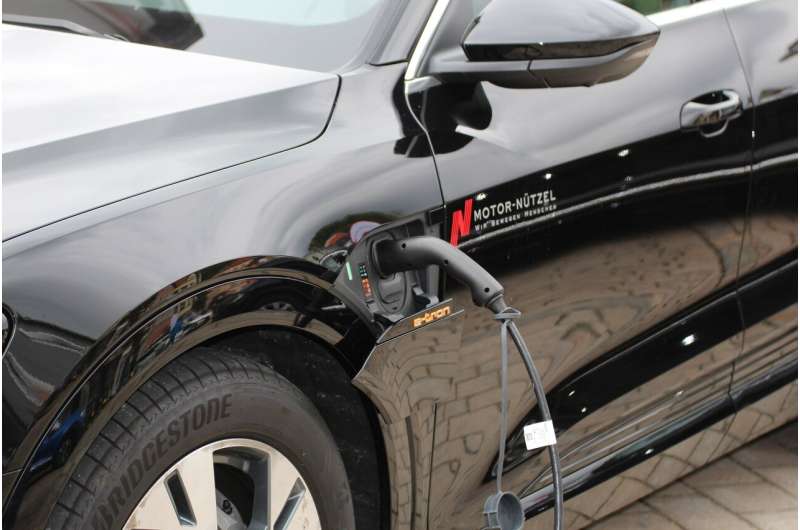
A new study shows that electric vehicle tax credits under the Inflation Reduction Act reduced pollution and boosted U.S. automakers, but largely benefited buyers who would have purchased EVs without subsidies.
New research by a team of economists shows that electric vehicle tax credits under the Inflation Reduction Act (IRA) have decreased climate pollution and boosted American car manufacturers, but at a price. Most car buyers benefiting from the subsidy would have purchased an electric vehicle anyway, raising questions about the taxpayer dollars spent pursuing the cleaner energy policy.
The study, published Oct. 7 as a working paper by the National Bureau of Economic Research, offers the most comprehensive look yet at the economic effects of the electric vehicle (EV) subsidies allowed for in the Inflation Reduction Act of 2022. Overall, the news is good: The EVs purchased after the law took effect have increased American automaker profits, put money into the pockets of consumers who receive the maximum $7,500 tax credit, and benefited the environment.
In economic terms, the researchers conclude that the new EV tax subsidies have reaped $1.87 in U.S. benefits for every $1 of government spending when accounting for subsidies that existed prior to the IRA. Under a scenario with no electric vehicle subsidies, however, the IRA policy generated only $1.02 in U.S. benefits per dollar of government spending.
From a tax policy perspective, the payoff has come at a price.
The researchers find that 75% of the EV subsidies claimed under the IRA have gone to consumers who would have bought an electric vehicle anyway. Thus, the scholars estimate that the government spends $32,000 for each additional EV sold.
"This policy is not a home run," says Hunt Allcott, a senior fellow at the Stanford Institute for Economic Policy Research (SIEPR) and a professor of environmental social sciences at the Stanford Doerr School of Sustainability, who co-authored the study. "While the IRA's electric vehicle tax credits have slowed climate change and shifted production to U.S. manufacturing firms, they also impose high costs on U.S. taxpayers."
The researchers suggest that the IRA could have been far more beneficial if it provided larger tax credits to cleaner EVs. The reason is that the environmental costs of driving an electric vehicle vary substantially across EVs. For example, switching from a hybrid Toyota Prius to an electric Tesla Cybertruck supports the adoption of cleaner-energy vehicles, but the Cybertruck generates more pollution.
Identifying trade-offs
Using detailed sales data from dealerships, the research team from Stanford; Duke University; the University of California, Berkeley; and the University of Chicago finds that EV buyers are by far the biggest beneficiaries of the IRA tax credits. Next up on the winner's list are U.S. car makers, and not just because EV sales have risen: The IRA requires that to be eligible for the tax credit, EVs must be assembled in North America and their main components sourced from the U.S. and its allies.
The researchers find that "ally-shoring," as the move by governments to strengthen supply chains is often called, has had mixed results.
"These subsidies have benefited U.S. consumers and U.S. firms, and have both helped and hurt U.S. allies," said Felix Tintelnot, an associate professor of economics at Duke. "U.S. allies have benefited from less climate pollution, but they've also lost profits to U.S. vehicle manufacturers."
The study's authors reached their conclusions using a unique dataset they compiled that included detailed records on vehicle prices, leases, and purchase decisions in the months before and after specific vehicle models gained and lost eligibility for the IRA subsidies. The researchers also applied a mathematical model of consumers' decisions about which vehicles to buy and auto manufacturers' decisions about which vehicles to sell.
"This 'Buy American' policy pits trade versus the environment," says Joseph Shapiro, an associate professor at UC-Berkeley who is currently a visiting scholar at the Stanford Department of Economics in the School of Humanities and Sciences. "The IRA subsidies have advanced vehicle electrification by limiting foreign competition. This is driving ahead on global climate policy but making a U-turn on global trade cooperation."
The study also analyzes the IRA's "leasing loophole," which lets any EV vehicle leases qualify for subsidies, no matter where the vehicle is manufactured. The study finds that this exemption mostly encourages consumers to acquire foreign-made vehicles and claim the tax credit without substantially benefiting the environment.
In addition to Allcott, Tintelnot, and Shapiro, the study co-authors are Reigner Kane and Max Maydanchik, both of the University of Chicago.
More information: Hunt Allcott et al, The Effects of "Buy American": Electric Vehicles and the Inflation Reduction Act, (2024). DOI: 10.3386/w33032
Citation: Study finds electric vehicle subsidies help the climate and automakers—but at a cost (2024, October 7) retrieved 7 October 2024 from https://techxplore.com/news/2024-10-electric-vehicle-subsidies-climate-automakers.html
This document is subject to copyright. Apart from any fair dealing for the purpose of private study or research, no part may be reproduced without the written permission. The content is provided for information purposes only.
